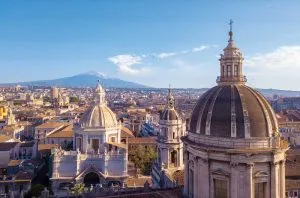Domes around Sant’Agata cathedral in central Catania with Mount Etna in the background to the north.
The east coast port of Catania is Sicily’s second-largest city after Palermo. Its central position means it is perfectly placed for trips south to Syracuse, Noto and Ragusa and north to Taormina and Mount Etna. As such it offers a gateway to the most interesting wine areas of eastern Sicily: to the south, Cerasuolo di Vittoria DOCG and Noto DOC for Nero d’Avola; and north for the exceptional Etna DOC wines of Carricante and Nerello Mascalese that have exploded onto the market in the past 20 years. It’s worth allowing a day or two to explore UNESCO World Heritage Catania before setting off on your wine tours.
Like so much of southeastern Sicily, Catania was decimated in 1693 by an earthquake, the destruction having been likened to London after the Great Fire of 1666. Gone were the layers of culture accumulated through centuries of Greek, Byzantine, Arab and Norman domination.
The buildings that rose from the rubble in these cities – including hundreds of churches and countless palazzi – were fortuitously built in the Baroque style, the fashion of the day. In Catania, the decorative drama is accentuated by the contrast of local black volcanic stone and white plaster and marble. The historic centre has benefited from investment in recent years and is handsomely laid out around an easy grid.
Where to stay
Treat yourself to a colourful stay in Hotel Asmundo di Gisira,







